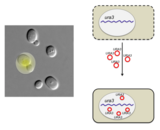
This resource is a video abstract of a research paper created by Research Square on behalf of its authors. It provides a synopsis that's easy to understand, and can be used to introduce the topics it covers to students, researchers, and the general public. The video's transcript is also provided in full, with a portion provided below for preview:
"The brain is the most complex biological structure known. All thoughts, movements, and behaviors are coordinated in this control center, where information is processed and transmitted in the form of electrical impulses and chemical signals. It perhaps comes as no surprise then, that alterations in this function can lead to neurological and psychiatric disorders. Now, a new study has pinpointed specific regions of a gene expressed in brain cells that appear to be associated with conditions such as developmental delay and intellectual disability. Neurodevelopmental disorders present early in life and are caused by impairments of growth, development, and function of the brain and central nervous system. With conditions including autism, attention deficit disorder, and schizophrenia, these disorders are characterized by deficits in cognitive, social, or personal functioning..."
The rest of the transcript, along with a link to the research itself, is available on the resource itself.
- Subject:
- Genetics
- Life Science
- Material Type:
- Diagram/Illustration
- Reading
- Provider:
- Research Square
- Provider Set:
- Video Bytes
- Date Added:
- 02/25/2021
